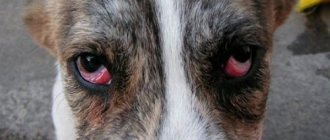The appearance of tears on the face of a four-legged pet cannot be ignored. In such a situation, it is very important to understand why the dog is crying and how you can help it. Despite the emotionality of these animals, in most cases their crying is explained by physiological reasons and serves as a symptom of a number of pathologies.
Can they do it and why?
Let's figure out whether they can and do, and why do dogs cry real tears? If by “cry” we mean shedding tears, then we can safely answer this question: yes, dogs can cry . Do dogs have tears - of course! All mammals can shed tears because they all have lacrimal glands. Dogs need tears to lubricate their eyeballs to prevent dust and other particles from accumulating on the surface of the eye.
According to zoological scientists, dogs shed tears not from an excess of emotions, but from a physiological need. Typically, tears in dogs are so small that they spread very quickly over the surface of the mucous membrane of the eye, without flowing onto the face. If your dog can clearly see tears running down his face, this may be a symptom of a health problem.
However, many owners fundamentally disagree with this opinion and believe that their pets may cry when they are upset about something or when they are sad. This can manifest itself in howling, pursed ears and tail.
According to dog handlers and animal psychologists, dogs, being constantly in the company of their owners, learn to interact and communicate with them. But, since they cannot speak purely physiologically, they use special signs to communicate : howling, whining, tail (either waving it, or tucking it in, or raising it high), ears (either lowering it, or vice versa raising it up). Therefore, what owners consider to be crying may be a sign that the dog is showing us that there is discomfort or stress.
Danger is nearby: why does a dog whine and how to wean it off?
Some breeds are friendlier
It is believed that some breeds are friendlier than others. Indeed, it is useful to learn more about the chosen breed before purchasing a dog. But this is not the key point. It is very important to find out the dog’s pedigree and the personal characteristics of the parents.
Coincidentally or not: why Lady Di put a necklace on her head, which upset the queen
Alexandra Shoua's eldest daughter grew up without him, but forgave him all his insults
They Can't Chew: Things That Are Very Difficult for Cats to Do
With proper upbringing and constant training, any dog will become a truly friendly companion and will accept the proposed model of social behavior.
Can it be from emotions?
Out of sadness
Despite the assertion of many zoologists and veterinarians that dogs are not capable of experiencing the same emotions that are characteristic of humans, most dog owners do not agree with them, sincerely believing that their dogs can cry from sadness. And every time they are convinced of this, observing in everyday life with their four-legged friend how he cries when the owner leaves home, when his favorite toy is taken away from him, or when he is not allowed to try an amazingly fragrant and tasty treat.
In their opinion, it is expressed not only by tears, but also by howling, whining, pursed ears and tail. And looking at pugs, you get the feeling that they are neither sad nor crying in life:
But many dogs know from their personal experience that if you just make a sad face, lower your ears and look into the eyes of the owner, you can immediately receive consolation in the form of a portion of affection and hugs, and if you are very lucky, then also a treat. This is why, while eating, many dogs almost fall into “depression”.
From gratitude
According to dog handlers and animal psychologists, dogs easily adapt to the environment, and especially to their owner, and their level of intellectual development is comparable to that of a three-year-old child. So dogs are not only very trainable, they can train their owner just as well .
Many owners have reported that their dogs cried with gratitude when they were allowed to do something that was previously prohibited. In fact, dogs perfectly capture the emotions of their owners, and can use them in their cunning and insidious plans. Just as a dog owner uses treats to reinforce desired behavior when training, dogs reinforce desired behavior in their owners. By shedding “tears of gratitude,” dogs are simply manipulating their owners.
For example, a dog is not allowed to sit on the sofa. And so she sits on the floor, looking with sad eyes at her owner. The owner can’t stand it and lets the dog onto the sofa, receiving a portion of “tears of gratitude” about him. And next time in a similar situation, the owner will be more willing to let the dog onto the sofa.
Similarly, pets teach their owners to feed them with goodies from the table, to take them with them all the time, and to pay attention to the dog even when they are very busy.
From resentment
No less common is the opinion of dog owners that their pets can cry tears of resentment. Many owners have encountered how, after scolding their pet for misdeeds, he tucks his ears and tail in resentment and begins to quietly “whine”, and some dogs also defiantly turn away or go away “to suffer from the insult.”
Observing this behavior of his pet, the owner is sure that his pet is crying from resentment. After this, most owners immediately forgive their pet’s offense, and a satisfied pet learns once and for all: if you make a sad face, look devotedly into the owner’s eyes and whine, then the owner becomes kinder and begins to feel sorry. And this pattern of behavior becomes firmly established.
Some representatives begin to be “offended” even by the fact that they were scolded for their misconduct. The thing is that dogs remember the sequence of actions of the owner and perfectly read his emotions. Therefore, noticing that the owner is starting to get angry, the cunning pet immediately demonstrates the behavior that usually replaces anger with mercy.
How to help a puppy or teach him not to cry when he's locked up or outside
I've encountered this. It's been a long time, really. The puppy cried terribly the first day, I gave him my old rabbit fur hat. He probably thought it was still a puppy and didn’t cry anymore. Maybe I should give him something fur too? :))
Let's try to find some kind of fur trap.
You can also try leaving for a few minutes and returning, each time increasing the time of absence - so that he understands that you are not leaving him and will definitely come soon. Absolutely right. Or - get dressed and NOT leave. Lock yourself away from him in the room/kitchen, scold him if he cries, scratch him, praise him if he was silent and didn’t ask. Praise + treat if you were silent for at least a minute or two. Then increase the time. Everything else is also an option, try it.
Why do tears flow from my eyes?
There are breeds in which, in principle, their eyes are always “wet”: Chihuahua, pug, toy terrier, French bulldog, etc. However, increased tearfulness can also be a symptom of an illness. The main reasons for the release of tears can be:
- Mechanical damage, which is a foreign body entering the eye. For example, dust, sand, wool, blades of grass, etc.
- Chemical damage . For example, if an aerosol or deodorant is sprayed near a dog, or chemical household products are abused in the house where the pet lives.
- Eye diseases: conjunctivitis, inflammation of the lacrimal sac, inflammation of the cornea, inflammation of the eyelids, etc.
- Infections in and around the eye.
- Poor nutrition . For example, feeding a dog sweets leads to the appearance of so-called “tear tracks.” They are especially noticeable in decorative breed dogs, since many owners like to pamper their little ones with cookies, ice cream or chocolate. Such food is not suitable for a dog, and the consequences of eating such food can be much more serious than unsightly tear tracks on the face. Similar to sweets, you should not give your dog spicy, salty, fried or smoked food.
- Allergy . Tears can be a symptom of allergies not only in humans, but also in dogs.
- where the dog lives is too dry
- Diseases of internal organs.
17 reasons why a dog howls and instructions on how to stop it
If your dog's tears are due to mechanical or chemical injuries, then you can help yourself. You can use special eye drops for animals or wipe your eyes with a cotton swab with chamomile infusion and water.
If tears flow due to dry air in the room, then you can use artificial tear drops to humidify the air.
In all other cases, you should not attempt to self-medicate; you should consult a veterinarian as soon as possible. The dog's health is the full responsibility of its owner.
If, along with tears, other symptoms appear, such as:
- green, yellow, or brown discharge in the inner corners of the eyes.
- The dog scratches its muzzle near its eyes, trying to scratch them.
- conjunctivitis,
- redness of the eyes,
- cloudiness of the eye, dull veil,
- swelling of the eyes,
- the dog blinks or squints its eyes frequently, cannot open its eyes,
- change in the size of the eyeball,
- blurred vision.
In such cases, you must rush to see a veterinarian immediately, otherwise the consequences can be dire. Why risk the health of your furry friend?
Males have a friendlier character
Veterinarians are confident that the gender of a pet does not affect its character. It doesn't matter whether it's a male or a female. The main thing is that you need to constantly work with the dog, work on its socialization. Then the pet’s character will be even and calm.
Aggression most often occurs when the dog is not neutered. At the same time, she is not taken for mating. Indeed, lack of sex can cause aggressive behavior.
Why in a dream?
Some owners notice that their dogs cry in their sleep. This phenomenon can have 2 reasons: a crying animal in a dream is bothered by something or is having a dream.
If the dog is bothered by something or is in pain, it will howl or whine for a long time. This may be accompanied by other symptoms: decreased activity, loss of appetite, desire to hide and retire. In such a situation, it is best to have your dog checked by a veterinarian.
Dogs, just like people, have dreams and visions . That's why some owners see their dogs howling, whining in their sleep and twitching their paws. This phenomenon is especially common in puppies. There's nothing wrong with that. Scientists, having conducted several studies of the brains of dogs, have found that they see more vivid and dynamic dreams compared to people. Therefore, their reaction to what happens in a dream is more violent.
For example, a dog dreamed that he was running after a cat in the yard. This sleep may be accompanied by paw movement, barking, or yelping. Or the dog dreamed that its beloved owner locked it. Then in her sleep she can howl and whine. Such dreams, as a rule, occur to dogs during the deep sleep phase, and usually do not last long. After it, the light sleep phase immediately begins and the animal calms down.
At the same time, you should not immediately run and wake up your pet, since it is during deep sleep that the nervous system is restored. And if you wake up the dog at this time, it will be disoriented and confused, it may not recognize its owner and be afraid of him or start growling.
So now you know whether dogs can cry and why they do it. You can share your stories and photos of your pets in the comments, as well as tell everyone about your experience or give advice to other dog breeders. We express our gratitude to you in advance!
Does behavior change after sterilization?
Veterinarians answer this question in the negative. There is no proven evidence that neutering affects a dog's personality or behavior. There is not even evidence that an animal becomes lazy and indifferent after surgery, although there is such a strong opinion among animal owners.
Neutering reduces the likelihood that your dog will mark his territory. Some dogs stop wandering.
Water scarcity on Earth is increasing: March 22 is World Water Day
We make a comfortable duvet cover with our own hands: you will need two sheets
First country in the world to vaccinate its entire adult population
Photos and pictures
Everything will work out, friend, I'm here!
Loneliness…
Physiological causes of dog tears
Tears in dogs can be caused by both serious health problems and simple irritation of the mucous membrane of the eye. Some dog breeds are more prone to eye diseases (for example, pugs), so their owners need to more closely monitor the condition of their pets' visual system.
A veterinarian can determine exactly why a dog is crying.
If your dog's eyes are constantly watering, this means that he needs to be taken to the veterinarian to prevent the development of the disease or stop contact with the allergen.
Note! Regularly appearing tears in a dog's eyes should alert the owners, who simply must immediately contact a veterinarian - this simple symptom may hide serious problems.
Allergy
Dogs, like people, have individual allergens, so the cause of an allergy can be anything: from food to detergents.
A recently purchased new household aerosol or a change in powder may be the cause of your pet's tears. If the allergen cannot be found on its own, then it is better for dog owners to contact a veterinarian who will help find the irritant and eliminate it.
Other signs of allergies include:
- swelling,
- rash,
- sneezing,
- cough,
- heat.
If you have one of them, you should inform your veterinarian, because detailed information will make it easier for the specialist to find the allergen.
Blocked tear ducts
As already mentioned, the tear ducts of dogs are different from those of humans. While in humans the tear ducts push fluid outward, in dogs they lead fluid toward the nose and throat.
External symptoms of blocked tear ducts resemble human crying. This discharge is called “epiphora” and has nothing to do with tears.
Epiphora is easily distinguished from other possible discharges by the fact that it causes irritation on the skin and turns the fur around the eyes brownish-red. If your pet exhibits symptoms of blockage, you should immediately contact your veterinarian.
Important! Blocked tear ducts can be easily identified by dark stripes of fur around the eye, stained with epiphora.
Infection
With an eye infection, the discharge from a dog's eyes is yellow or bloody and has a slimy texture.
Swelling and redness of the area around the eyes is also common. Having noticed one (or both) symptoms in a dog, the owners need to consult a doctor as soon as possible, before the animal’s vision and health are affected.
Foreign body in the eye
Another common cause of dog tears is a foreign body in the eye area. You can check for debris in your pet's eye by carefully lifting first the upper and then the lower eyelid.
To avoid causing irritation, any contact with the dog’s eye should be finished by rinsing with cold water or a special eye cleaning liquid.
If a foreign body in a dog’s eye is difficult to remove with your hands, there is no need to try to do it yourself; you need to apply a bandage to the dog’s head and take it to the doctor.
Note! On the way to the doctor, you should not allow your pet to touch the affected eye with its paw - it can damage it.
Scratch on the cornea
This often happens with active and playful dogs that are in contact with their peers. During the game, animals can damage each other's eyes.
In such cases, the pet constantly cries and rubs its eye with its paw - it should be taken to the doctor to prevent complications and loss of vision.
Memo to the owner
- Dogs do not experience the same range of emotions that are characteristic of humans, so their tears flow not from emotional experiences, but from certain reasons.
- The reasons for the secretion of tears can be either breed characteristics, mechanical or chemical damage to the eye, or diseases.
- You can help your pet yourself in cases where there was mechanical or chemical damage, or due to dryness in the room. To do this, you need to use special eye drops or chamomile tincture in water.
- Eyes can also become watery from poor diet: do not feed dogs sweets, salty, spicy, fried or smoked foods.
- If your eyes are watering for other reasons, you should consult a veterinarian.
- There are a number of symptoms, other than watery eyes, that indicate serious health problems in your dog. In such cases, you should definitely visit a veterinarian.
- What owners usually mean by crying (howling, whining, drooping ears and tucked tail) are signs dogs use to communicate with their owners.
- Dogs may use signs that are commonly mistaken for crying to indicate discomfort or stress.
- Dogs can manipulate their owners, crying out of sadness, resentment or gratitude, not from an excess of emotions, but in order to receive a portion of affection or a treat.
- Dogs may cry in their sleep. The reasons can be anxiety and pain, as well as dreams and daydreams. In the first case, this may be accompanied by symptoms such as refusal to eat, decreased activity, or an attempt to retire.
- Love and help animals - they so need our strength and care!
Remember! The health and well-being of the pet depends entirely on the owner! Be attentive to your pet, learn to read the signs that it shows you, and if suspicious symptoms appear, do not experiment with self-medication, but contact a veterinarian.
Is it possible to feed your pet only dry food?
Veterinarians are clear on this issue. However, one condition must be observed - the food must be of high quality. It must meet all nutrient requirements. Food should always be selected depending on the age and breed of the dog. Be sure to check whether the food you choose has been certified.
Owners should also remember that with such a diet, the dog should always have water freely available and in sufficient quantity. If you are in doubt about the choice of food, it is best to consult your veterinarian.
Dangerous symptoms
Any abnormalities in the functioning of the eyes are potentially dangerous for the dog’s vision and vital functions, so they should not be left to chance.
Some symptoms indicate your dog's vision is at risk.
But, if in case of an allergy or simple irritation of the eye, the owners can wait until the redness and tearing goes away on their own; some symptoms require immediate medical attention:
- Severe redness.
- Rapid blinking.
- Formation of a film or crust on the eye.
- Refusal to open an eye.
- Colored highlights.
Owners should monitor the health of their pets' eyes
Just because dogs can't cry the way humans do doesn't mean they don't experience emotions. It’s just that animals express their sorrows and joys in a completely different way. When, for example, a dog experiences pain, sadness or bitterness of separation, he tries to convey this vocally: howling, hissing or whining.
Therefore, having noticed a dog’s tears, owners should not worry about the emotional state of the pet; it is better to think about its health. You should not take pictures of him for the sake of likes or classes, but it is better to immediately contact a veterinarian.
Surely many have heard this wonderful poem, in which S. Yesenin tried to express the depth of feelings of a dog experiencing the grief of loss. Some heard it in elementary school, others at a more conscious age. Many dog breeders sincerely believe that dogs can experience the full range of emotions characteristic of humans.
A dog is man's best friend. Many people perceive their pet as a member of the family, like a child. Many people humanize a dog by transferring their feelings and experiences onto the pet. From there comes the confidence of dog owners that their pets can, just like people, cry from grief or resentment, shed tears of joy and gratitude.
Let's find out if it's true that dogs can, and do they even know how to cry with tears in their eyes?











